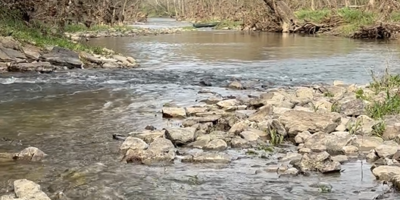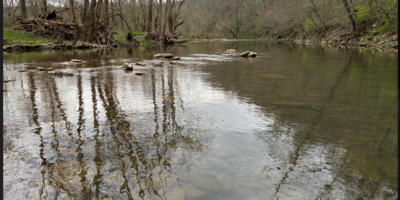3-layered approach provides direction for growth, sets attainable goals
By Amber Scott
The Legacy Trail, a nine-mile multi-use path connecting the east side of downtown Lexington to the Kentucky Horse Park, received final approval on March 11, which is good news considering the whole thing is supposed to be finished and decorated by September’s World Equestrian Games. Yes, finished and decorated. By September.
It’s the decorated part that’s most interesting to me. Sure, a winding path through Kentucky’s greenspace usually only accessible via drive-by sounds delicious—and will make a bike ride in this town way less life threatening—but the thing that makes this better than just a sidewalk through a prairie is all the decoration.
The Legacy Center at Blue Grass Community Foundation (BGCF) is spearheading the trail effort, which involves:
- a Public Art Consortium (made up of citizen volunteers, LexArts, Lexington Art League, UK’s Museum Studies Class, LFUCG and BGCF),
- a Narrative Committee charged with creating the story of Lexington’s history, culture and environment that will be told along the trail,
- and the actual builders of the trail, led by engineer Keith Lovan.
Construction of a six-mile stretch connecting Northside YMCA to the Horse Park started last week, and as that work progresses, so will the decorating.
On Feb. 23, Stacy Levy and Todd Bressi, consultants hired to create the Legacy Trail Public Art Master Plan, presented a three-layered approach to getting public art along the trail, showing particular sensitivity to time constraints, uncertain future funding, and sustainable artist involvement.
“The folks who are organizing the trail are very interested in having the artwork align with the narratives along the trail to make it a museum without walls and to provide ways of working with artists from the region,” said Bressi. “There are types of artists in the Bluegrass who don’t necessarily have experience creating public art, and we wanted to figure out ways for artists who aren’t public artists to create things that go along the trail. There is also the reality that there’s not a lot of money to start with, so how do you create a lot of splash without a lot of money?”
Layer 1: Art signs
The first phase, or layer as Levy and Bressi call it, is at first glance a bit underwhelming—and for good reasons that aren’t necessarily obvious at first glance. The primary purpose of Layer 1 is to integrate functional artwork into the trail. Rather than posting a sign here or an arrow there, art will be used to indicate the direction and location of the trail.
Blazes, which are 25-foot tall poles visible even at great distances, will line the trail in clusters of 3-5. Each blaze will have a “flag” designed by an individual artist, and these flags can be updated or exchanged in the future.
The blazes are a good example of the subtle genius Bressi and Levy are employing in Layer 1 and beyond. By installing 25-foot poles as permanent fixtures along the trail but making their art component exchangeable, they are providing an opportunity for artists to have an on-going involvement in the trail and opening the door for more artists to participate. Public art tends to favor installation artists or sculptors, but these flags invite 2-D artists like printmakers, painters, graphic designers and even quilters to participate.
For the people on the trail, the flags provide a point of interest that won’t become stagnant in the way a fixed sculpture may. What you see on your first visit may not be what is mounted on your second, and the experience you have along the trail will change as new art replaces old.
In addition to blazes, Levy and Bressi identified crossings and pavement tapis as affordable and executable forms of public art that can be completed by September. Crossings will identify the trail’s direction at points of intersection or disconnect. For example, when the trail crosses Newtown Pike, a crosswalk at the intersection will be more than the crosswalks you see downtown. It will be a functional piece of pavement art that signifies the continuation of the trail.
Pavement tapis are sort of rugs painted on the trail itself. The plan is for them to be elliptically shaped and to tie in to the narratives at certain points along the trail. Pavement tapis could last as long as 8 years, but because they aren’t permanent, they allow an opportunity for future engagement with additional artists also.
Layer 1 is scheduled to be completed in September, and because of the short time from conception to installation, Austin said there will be a rolling call for artists who want to be involved likely being issued next week.
“With the roster call, we want to build a good base of people who are interested in art on the Legacy Trail,” said Steve Austin, director of the Legacy Center. “Some of them will work on the first phase for the opening, and others will be held in reserve until later phases.”
A selection committee will choose local, regional and national artists for the roster based on a sample portfolio as opposed to a specific proposal. Once selected, artists will be “on-call” to complete their projects as sections of the trail are constructed.
The short timeline from acceptance to installation shows another bit of brilliance in Bressi and Levy’s plan. Artists could have just a few weeks to a couple months to design and create the work for the trail, and if Layer 1 involved more complicated pieces they probably wouldn’t be finished by opening day.
Building long term: Layers 2 and 3
Layer 2, which is slated for 2011, has time for observation and experimentation built into it.
“Once the trail opens and before it can be populated with art that is relevant, we need to see how the trail is being used, where people are naturally stopping, what points are attracting the most interest. We also need a year of traction just to see what the different seasons bring,” noted Bressi.
“It’s very hard to understand what it’s going to be like to be on this trail since it’s not there yet. You have to come up with a plan that can evolve as you learn more about the trail, and that’s what Layers 2 and 3 do.”
Temporary installations, the focus of Layer 2, provide a bridge between the functional art of Layer 1 and the permanent art of Layer 3. The installations will engage more artists and generate renewed interest for the public. They allow for experimentation without commitment and satisfy the public’s desire for more robust works of art along the trail.
With insight gained from a year of temporary installations, placing permanent art fixtures along the trail will be a more organic process.
Because Layer 3 brings in lasting pieces, it is the most significant legacy we’ll be leaving aside from the actual trail itself. Expected to begin in 2012 at the earliest, Layer 3 gives us time to raise funds and understand the way the trail is being used before putting in anything that will be here for, hopefully, generations to come.
Examples of Layer 3 features include what Levy and Bressi call garden rooms, gathering places, infrastructure and trailheads. Garden rooms are areas where art and landscape come together – not actual rooms. They’ll be installed where people tend to stop and explore narratives along the trail, provide shade or seating and channel attention toward the environment along the trail. Gathering places will use public art to create seating, play areas or vista points and will be placed where people tend to gather along the trail during Layers 1 and 2.
Infrastructure, such as tunnels going under roads, retaining walls, medians and the sides of buildings, also gets attention in Layer 3. By adding public art to these necessary features, they become more pedestrian friendly and overall more interesting. Trailheads are the grand finale of the Legacy Trail Public Art Master Plan. There are only a few designated trailheads, and because these are such critical spots along the trail, they have to create a sense of welcome and discovery.
“One of the goals is to get people to use the trail, so having artwork along the trail is a good way to pull people in,” said Bressi. “Instead of having something right at the trailhead, have it a mile away so that people come in and experience the trail. After you get people using the trail, then you can install beautifully designed trailheads.”
To date, $13 million has been raised for the trail, and that total doesn’t include grants and right of way values. An additional $150,000 has been raised for Layer 1’s public art through foundations, public grants and private donations, and Austin said the goal is to raise another $50,000. Estimates for Layers 2 and 3 will be revealed during the unveiling of the final Legacy Trail Public Art Master Plan on April 13 at 7 P.M. at the Downtown Arts Center.
“The trail was a project chosen by the community, and it says something great about us that we chose this project when we could’ve chosen any other,” said Austin. “It says a lot about where we as a city want to go. There’s a lot of good stuff coming.”
For more information about the progress of the Legacy Trail or to view the first draft of the trail’s Public Art Master Plan, visit www.legacycenter.ning.com.




1 Pingback